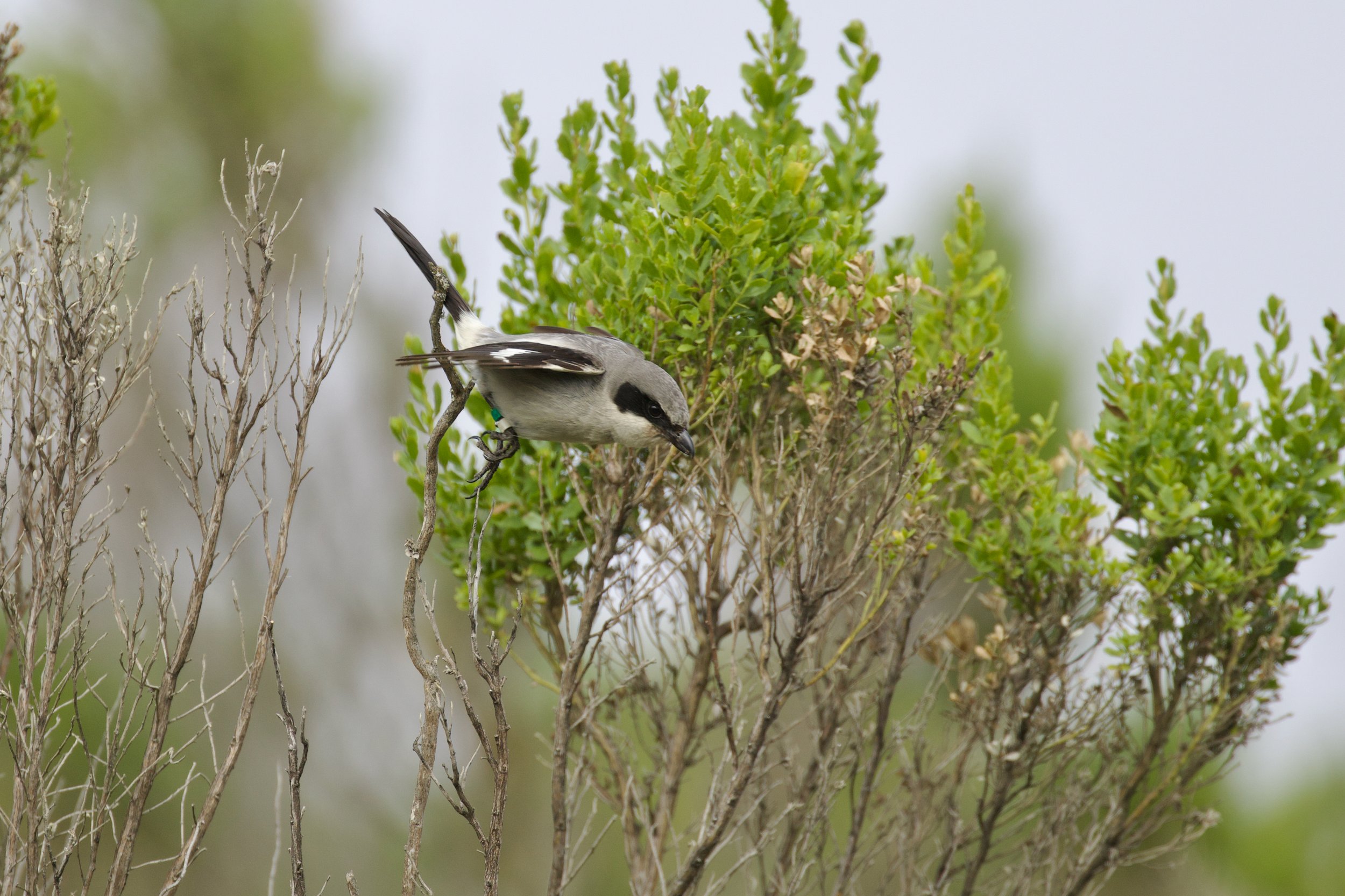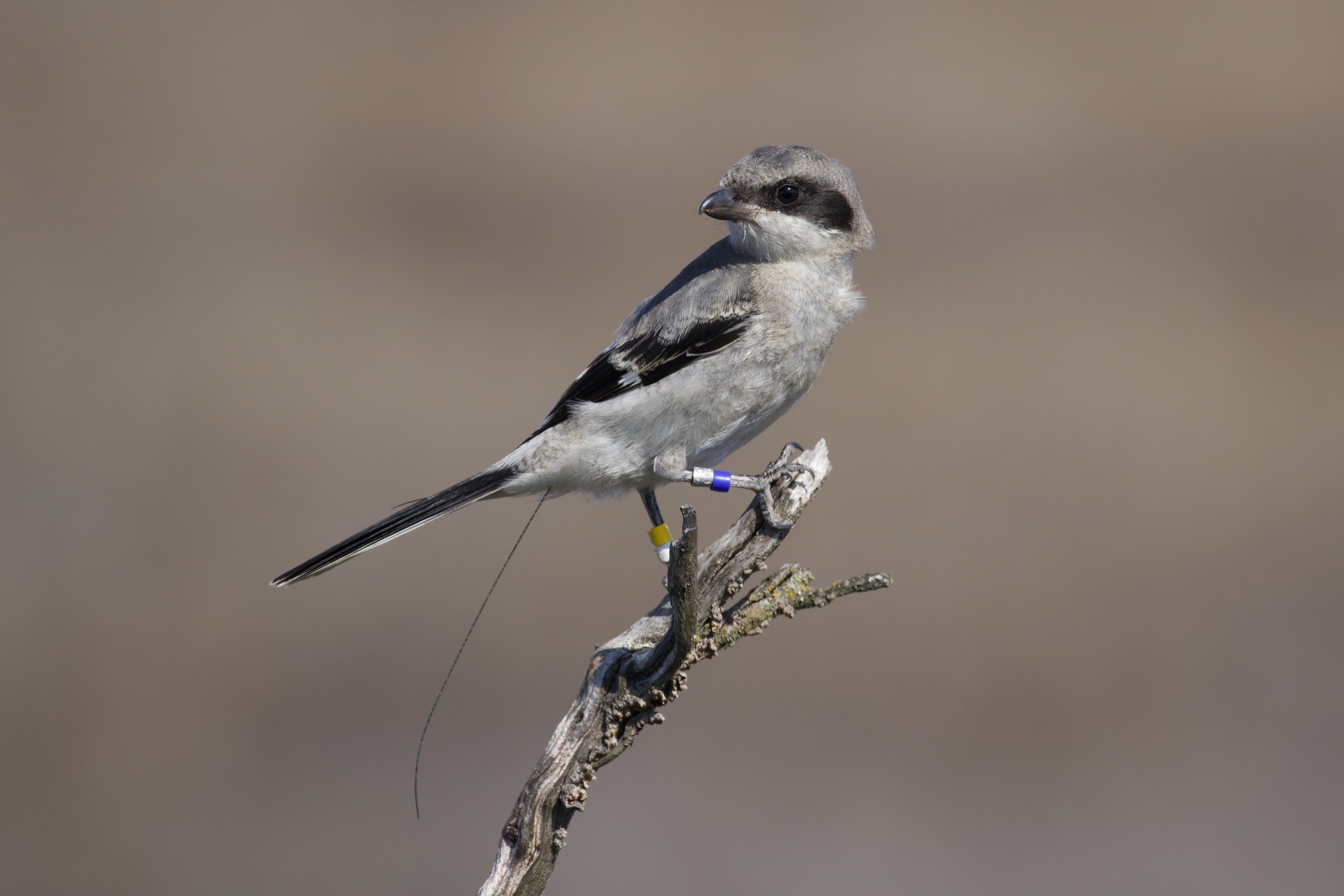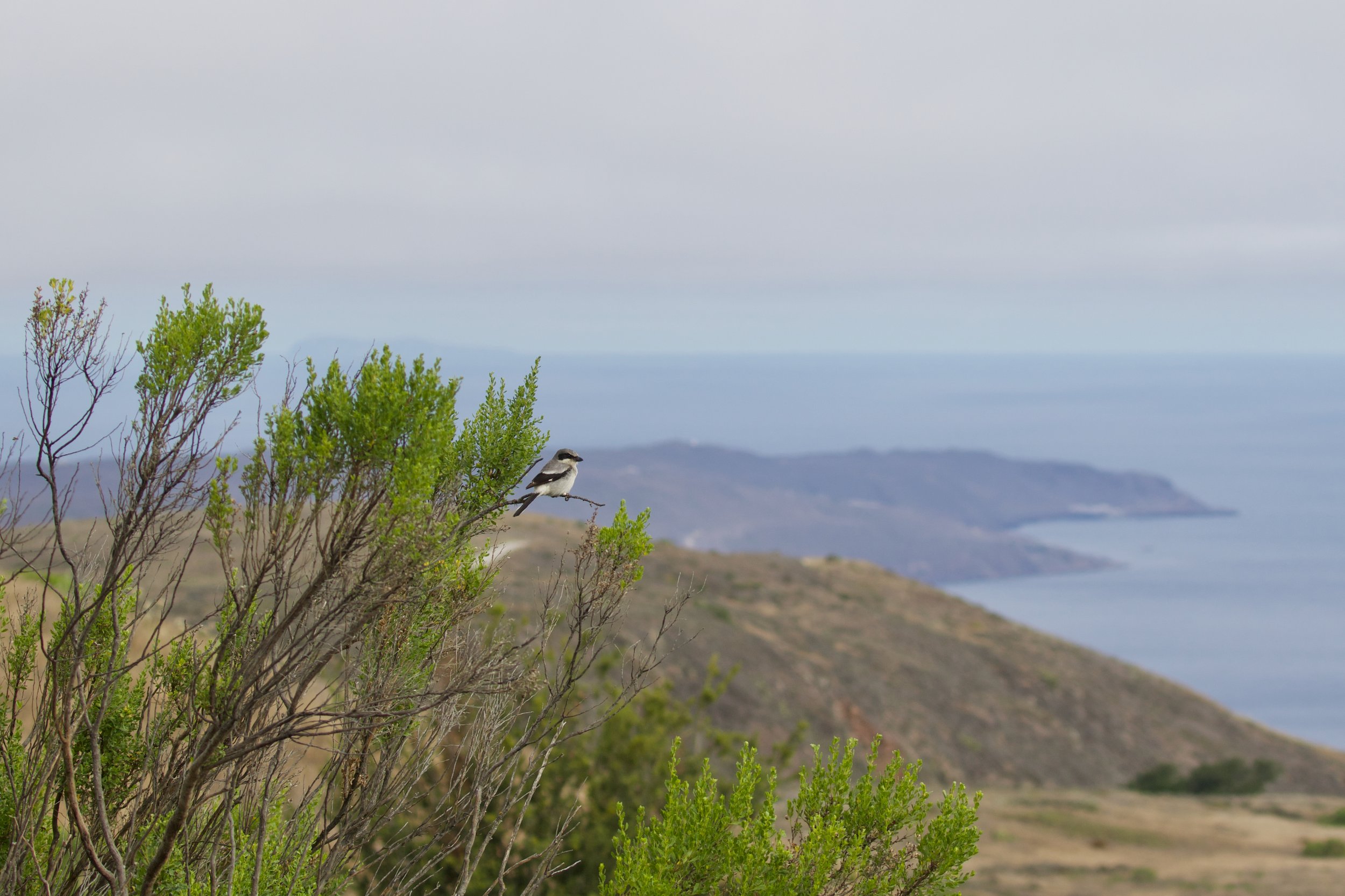
San Clemente Loggerhead Shrike
Lanius ludovicianus mearnsi
The San Clemente loggerhead shrike (Lanius ludovicianus mearnsi) is an endemic subspecies inhabiting San Clemente Island (SCI), California. This year-round resident breeds March–July, laying 4–6 eggs per nest. Shrikes are medium-sized songbirds, clad in gray, black, and white, and can be found in the canyon woodland and shrubby plateau habitats of SCI. Known as “butcher birds,” shrikes possess a unique foraging strategy among passerines. Despite weighing only 50 grams, they are capable of taking small mammals, birds, and lizards that may be equal to their own weight. Utilizing their tomial tooth (a sharp protrusion on the edge of the upper mandible), shrikes bite prey at the base of the spinal cord to paralyze them. Once prey are immobilized, shrikes will impale or wedge them onto a sharp or forked object, such as barbed wire or a broken or forked branch. This unique adaptation allows shrikes to make use of mechanical advantage, enabling them to capture and manipulate larger prey items, without possessing strong, raptorial feet. (Header photo credit: Nicole Desnoyers).
A San Clemente Loggerhead Shrike leaps off a perch in pursuit of prey June 2021. Photo Credit: Nicole Desnoyers.
Released juvenile shrike with transmitter, July 2018.
Photo Credit: Nicole Desnoyers
Tomial tooth on display.
Photo Credit: Nicole Desnoyers.
In the late 1880s and early 1900s, naturalists described shrikes as being “fairly well distributed,” “tolerably common,” and “seen daily” on SCI. The subspecies was listed as endangered under the U.S. Endangered Species Act in 1977, and by 1983, the SCLS population had fallen to approximately 20–30 birds. Scott and Morrison initiated a more intensive population estimation study in the mid-1980s, and their estimates ranged from 17–30 individuals. Researchers speculated that predation by introduced cats (Felis catus) and black rats (Rattus rattus) contributed to the decline of the SCLS, and that damage to nesting habitat by introduced sheep (Ovis aries) and goats (Capra hircus) hindered population recovery.
Due to the critically low population size, an intensive management plan was necessary to prevent extinction. This plan was outlined in the early 1990s and consisted of 5 components: captive breeding, release of captive-bred birds into the wild, predator control, population monitoring, and habitat enhancement. As the multi-faceted management plan was implemented in phases throughout the 1990s, the shrike population remained very low in the wild, with estimates ranging from 33 adults in 1994 to only 14 adults in January 1998.
Banding nestlings. Photo Credit: Jeremiah Psiropoulos
Juvenile San Clemente Loggerhead Shrikes begging for food, July 2021. Photo Credit: Nicole Desnoyers.
IWS first became involved with the shrike recovery program in 1996 with the development of remote video monitoring systems intended to document the causes of nest failure. In 1997 the U.S. Navy contracted IWS to develop a research protocol to better understand shrike habitat requirements, and to propose improved methods for releasing captive-bred shrikes into the wild. Attempts had been made to release captive-bred shrikes into the wild beginning in 1992, and between 1992 and 1994, 32 captive-bred juveniles were released.
With the exception of 1 individual, which was observed on SCI for 8 subsequent months, none were resighted >90 days post-release. During 1995 and 1996, 8 adults between 1–4 years old were released from the captive population. They were subsequently observed alive for an average of 30 days post-release. No releases were conducted in 1997 or 1998.
In 1999, releases resumed, with IWS now managing the release effort, utilizing soft-release techniques and hack site attendants. In 1999 the recovery program hit a major milestone when the first released shrikes survived the winter and recruited into the next season’s (2000) breeding population. Release methodologies were modified through the following years, and by 2021, a total of 729 captive-bred shrikes have been released into the wild on SCI.
This figure shows the adult population size (potential breeding population) of the San Clemente loggerhead shrike each year since 1985. You can see the population growth following the first successful release of captive-bred birds in to the wild.
IWS was also contracted to implement a predator research and management program in 1999. This program focuses on innovative methods to monitor predator populations, control non-native predator populations, and protect shrikes from predation by both native and non-native predators. Nest monitoring via video camera systems has provided valuable nest predation data, allowing the recovery program to adapt and employ the best methods possible for nest protection. Rat control efforts within shrike territories have had a positive effect on shrike reproductive output, where sites receiving treatment produce nearly twice the number of independent offspring compared to untreated sites. Aluminum flashing is also installed on nest trees to reduce nest accessibility by both foxes and rats.
In 2006, IWS was contracted to monitor the status, distribution, and population trends of the wild shrike population on SCI. The objectives of the monitoring program are to: 1) determine the minimum population of shrikes on SCI; 2) determine the number of shrike breeding pairs and measure reproductive success; 3) band and monitor shrike nestlings, fledglings, breeding pairs, solitary adults, and released adults and juveniles; 4) identify winter territories and movement patterns of adults and juveniles in the non-breeding season.
Under the recovery program funded by the U.S. Navy (Commander, U.S. Pacific Fleet), the shrike population has grown in size from its low of 14 in 1998 and the breeding range now encompasses the southern two-thirds of SCI. All 5 components of the management plan are still in action, with the ultimate goal of achieving a resilient self-sustaining shrike population on the island. The recovery program continues to adapt and plan for future conditions that may hinder the recovery effort, especially those that may arise from climate change.
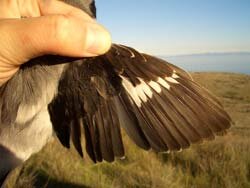
Checking for wing wear/molt
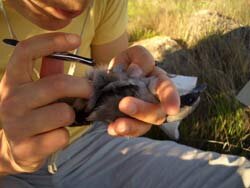
Checking for parasites

Weighing shrike in a bag
The Institute for Wildlife Studies (IWS) is proud to be a member of the recovery effort of this imperiled songbird, working cooperatively with the U.S. Navy, U.S. Fish and Wildlife Service, the San Diego Zoo Wildlife Alliance, and the Soil and Ecology Restoration Group of San Diego State University.
